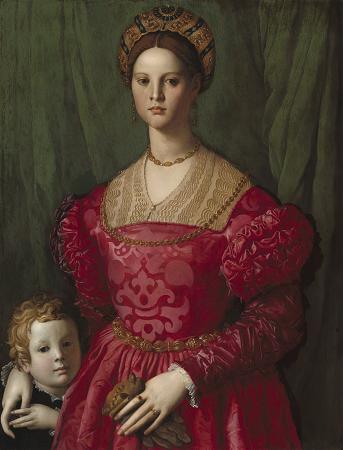Agnolo Bronzino (1503 - 1572). Agnolo di Cosimo, usually known as Bronzino or Agnolo Bronzino, was an Italian Mannerist painter from Florence. His sobriquet, Bronzino, may refer to his relatively dark skin or reddish hair. He lived all his life in Florence, and from his late 30s was kept busy as the court painter of Cosimo I de' Medici, Grand Duke of Tuscany. He was mainly a portraitist but also painted many religious subjects, and a few allegorical subjects, which include what is probably his best known work, Venus, Cupid, Folly and Time, c. 1544-45, now in London. Many portraits of the Medicis exist in several versions with varying degrees of participation by Bronzino himself, as Cosimo was a pioneer of the copied portrait sent as a diplomatic gift. He trained with Pontormo, the leading Florentine painter of the first generation of Mannerism, and his style was greatly influenced by him, but his elegant and somewhat elongated figures always appear calm and somewhat reserved, lacking the agitation and emotion of those by his teacher. They have often been found cold and artificial, and his reputation suffered from the general critical disfavour attached to Mannerism in the 19th and early 20th centuries. Recent decades have been more appreciative of his art. Bronzino was born in Florence, the son of a butcher. According to his contemporary Vasari, Bronzino was a pupil first of Raffaellino del Garbo, and then of Pontormo, to whom he was apprenticed at 14. Pontormo is thought to have introduced a portrait of Bronzino as a child into one of his series on Joseph in Egypt now in the National Gallery, London. Pontormo exercised a dominant influence on Bronzino's developing style, and the two were to remain collaborators for most of the former's life. An early example of Bronzino's hand has often been detected in the Capponi Chapel in the church of Santa Felicita by the Ponte Vecchio in Florence. Pontormo designed the interior and executed the altarpiece, the masterly Deposition from the Cross and the sidewall fresco Annunciation. Bronzino apparently was assigned the frescoes on the dome, which have not survived. Of the four empanelled tondi or roundels depicting each of the evangelists, two were said by Vasari to have been painted by Bronzino. His style is so similar to his master's that scholars still debate the specific attributions. Towards the end of his life, Bronzino took a prominent part in the activities of the Florentine Accademia delle Arti del Disegno, of which he was a founding member in 1563. The painter Alessandro Allori was his favourite pupil, and Bronzino was living in the Allori family house at the time of his death in Florence in 1572. Bronzino spent the majority of his career in Florence. Bronzino first received Medici patronage in 1539, when he was one of the many artists chosen to execute the elaborate decorations for the wedding of Cosimo I de' Medici to Eleonora di Toledo, daughter of the Viceroy of Naples. It was not long before he became, and remained for most of his career, the official court painter of the Duke and his court. His portrait figures, often read as static, elegant, and stylish exemplars of unemotional haughtiness and assurance, influenced the course of European court portraiture for a century. These well known paintings exist in many workshop versions and copies. In addition to images of the Florentine elite, Bronzino also painted idealized portraits of the poets Dante and Petrarch. Bronzino's best known works comprise the aforementioned series of the duke and duchess, Cosimo and Eleonora, and figures of their court such as Bartolomeo Panciatichi and his wife Lucrezia. These paintings, especially those of the duchess, are known for their minute attention to the detail of her costume, which almost takes on a personality of its own in the image at right. Here the Duchess is pictured with her second son Giovanni, who died of malaria in 1562, along with his mother; however it is the sumptuous fabric of the dress that takes up more space on the canvas than either of the sitters. Indeed, the dress itself has been the object of some scholarly debate. The elaborate gown has been rumored to be so beloved by the duchess that she was ultimately buried in it; when this myth was debunked, others suggested that perhaps the garment never existed at all and Bronzino invented the entire thing, perhaps working only from a fabric swatch. In any case, this picture was reproduced over and over by Bronzino and his shop, becoming one of the most iconic images of the duchess. The version pictured here is in the Uffizi Gallery, and is one of the finest surviving examples.
more...














